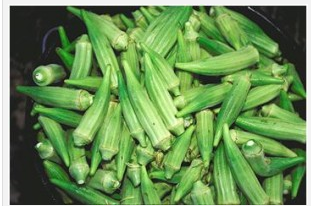Okra, also known as lady’s fingers or gumbo, is among the most popular indigenous vegetables grown in Africa and Asia. This uniquely-shaped pod vegetable is believed to have originated in Southeast Asia, with the most common of the okra species, Abelmoschus esculentus, particularly popular in tropical Africa, Southeast Asia, and Brazil, and another species, Abelmoschus caillei, popular in West Africa. The pods can be cooked and eaten, or dried or pickled for preservation, while the leaves can be eaten like spinach. Okra is not only nutritious – its seeds contain protein – but it also adds taste and variety to staple foods around the world, including sorghum, rice, and maize. While some find its slimy texture unpleasant, it works as a natural thickener in soups and stews.

Okra was introduced to the United States in the eighteenth century and became a staple of southern food, eaten not only in gumbo, but fried in cornmeal and cooked in a variety of other ways. In West Africa, okra pods are picked and eaten while small and tender, while in India, okra is harvested when pods are more mature. Around the world, okra can be found in India’s sambar, thick stews in the Mediterranean, canh chua in Vietnam, and callaloo in the Caribbean. It is also a master of disguise: when coffee was in short supply during the Civil War, many people resorted to a coffee substitute made from okra seeds.
In addition to being delicious, okra has a number of truly surprising uses. Okra mucilage has been used as a plasma replacement and blood volume expander. Okra bark fiber can be spun into rope and used to manufacture paper. And a 2009 report in Applied Energy found okra seed oil to be a suitable feedstock for biodiesel.
Okra is quite robust, tolerating heat and drought, and able to survive poor soil conditions that less resilient vegetables cannot. While it thrives in warm weather on the vine, okra easily bruises and quickly desiccates after picking if it is not kept relatively cool. Its sensitivity and potentially short shelf life make storage capability key for farmers in tropical climates seeking to sell their okra at a market, and storage can present a formidable challenge. Practical, accessible innovations like the zeer pot can prolong okra’s freshness, helping warm weather farmers minimize the loss of their produce to heat damage.
Considering the endless ways to eat okra, and its many surprising applications, it’s no wonder that this indigenous vegetable has been a favorite of so many different cultures around the world throughout time. With okra’s resilience and tolerance for less-than-ideal soil and climate conditions, it will certainly continue to be a favorite among farmers working under the erratic and unpredictable conditions wrought by climate change.
To read about other indigenous crops, see: Horned Melon: Fruit, Vegetable, Decoration, Sugar Apple: More than just a tropical snack, and Tomatillos: Adding Zest to Central American Livelihoods for Millennia.
By Kate Rosenberg

Danielle Nierenberg, an expert on livestock and sustainability, currently serves as Project Director of State of World 2011 for the Worldwatch Institute, a Washington, DC-based environmental think tank. Her knowledge of factory farming and its global spread and sustainable agriculture has been cited widely in the New York Times Magazine, the International Herald Tribune, the Washington Post, and
other publications.
Danielle worked for two years as a Peace Corps volunteer in the Dominican Republic. She is currently traveling across Africa looking at innovations that are working to alleviate hunger and poverty and blogging everyday at Worldwatch Institute’s Nourishing the Planet. She has a regular column with the Mail & Guardian, the Kansas City Star, and the Huffington Post and her writing was been featured in newspapers across Africa including the Cape Town Argus, the Zambia Daily Mail, Coast Week (Kenya), and other African publications. She holds an M.S. in agriculture, food, and environment from Tufts University and a B.A. in environmental policy from Monmouth College.








